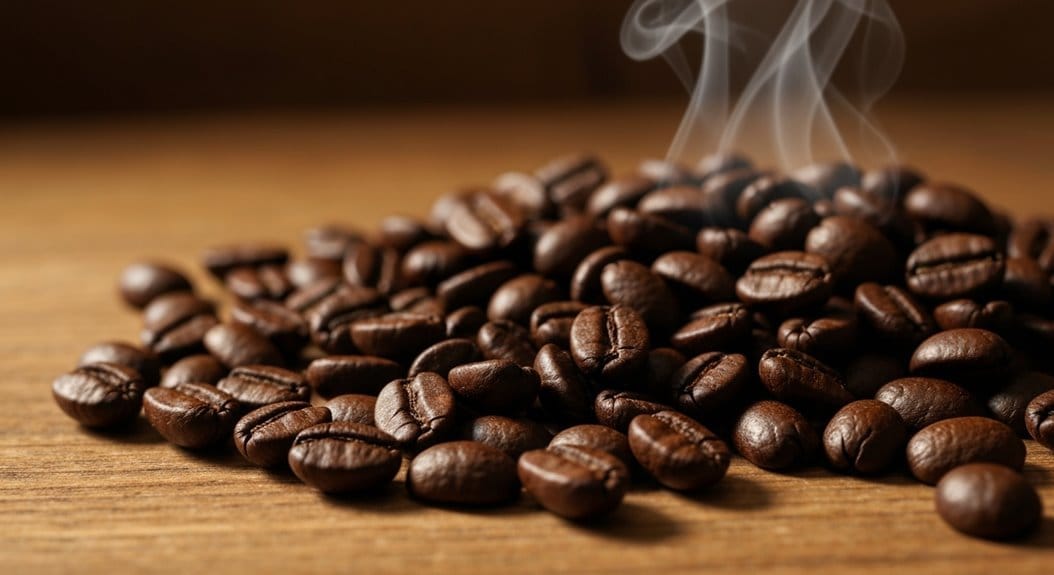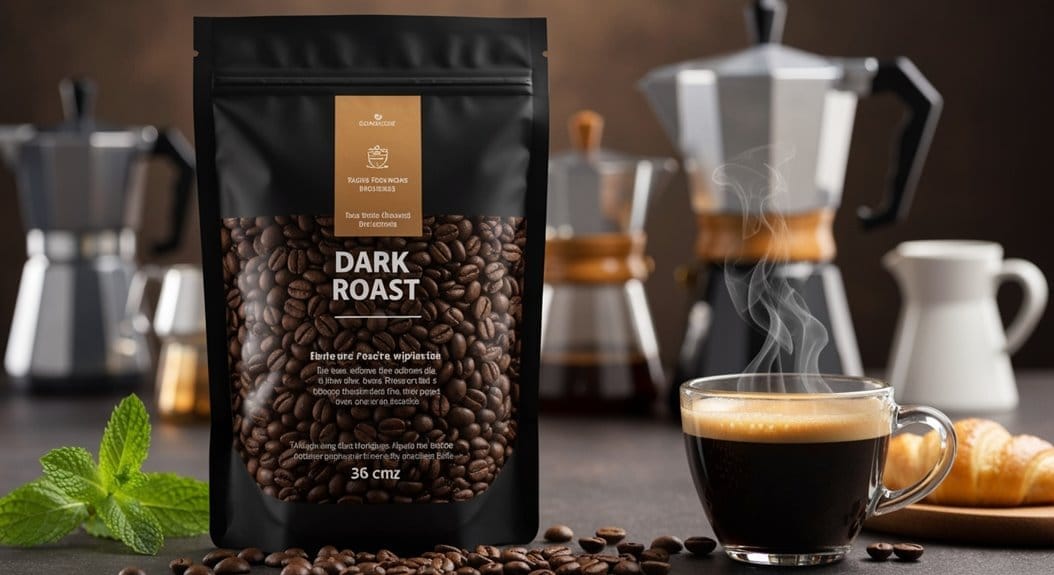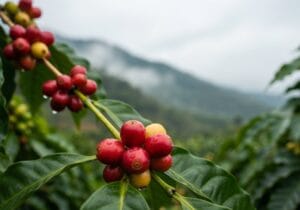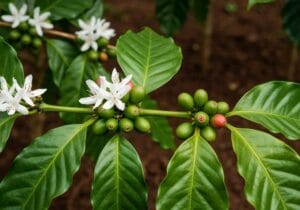Dark roast coffee, oh boy, it’s like the superhero of brews! Roasted at high temps, those beans turn deep brown, shiny, and oh-so-bold! With low acidity, it’s smooth and full-bodied—like that friend who always knows how to cheer you up, right? It’s choco-tastic with hints of caramel and just a pinch of spice! Plus, it’s perfect for espresso or French press, just like your go-to pick-me-up on a Monday morning! And seriously, there’s so much more to uncover!
Key Takeaways
- Dark roast coffee is made from beans roasted at temperatures between 430°F and 465°F, resulting in deep brown, oily beans.
- The roasting process reduces acidity, providing a smoother, fuller-bodied flavor profile.
- Flavor notes include rich chocolate, caramel, and hints of dark chocolate and spices like cinnamon.
- Dark roast beans are versatile, suitable for brewing methods such as espresso, French press, and cold brew.
- Popular dark roast varieties include French Roast, Black Velvet, and Espresso Forte®, each offering unique tasting experiences.
Definition and Characteristics of Dark Roast Coffee
Regarding coffee, dark roast is like that trusty old friend who always knows how to bring the party—bold, deep, and ready to take things up a notch!
Dark roast coffee comes from beans roasted at higher temperatures, usually between 430°F and 465°F, venturing into the land beyond the subsequent crack, where smoky magic happens. This curious process makes beans lose moisture, becoming less dense and transforming into dark brown beauties with a shiny, oily surface. Moreover, the longer roasting process contributes to the reduced acidity of dark roast coffee, resulting in a smoother, fuller-bodied experience.
Dark roast coffee, where high heat and smoky magic create shiny, oily beans that deliver bold, rich flavor.
Now, if you’re thinking about brewing methods, don’t fret! Dark roasts work well with many styles, from espresso to French press, giving even the weakest caffeine content a robust punch.
Who knew getting your morning pick-me-up could feel like a delightful mini-celebration?
Flavor Profile of Dark Roast Coffee
When coffee lovers plunge into the bold world of dark roast, they’re often surprised by the sheer depth of its flavor profile—like finding an extra fry at the bottom of the bag.
The flavor intensity is undeniable, boasting rich, chocolatey notes that dance with creamy caramel, fresh cola, and dark chocolate. Oh, and let’s not forget those spicy undertones—cinnamon and nutmeg make surprise appearances!
While you sip, a heavy body and low acidity wrap around your tongue, creating something smooth yet surprisingly balanced. It’s like a warm hug for your taste buds!
Sure, it might lack the bright, fruity aromatic notes of lighter roasts but hey, sometimes you just crave that comforting, bold kick without a side of acidity.
Physical Characteristics of Dark Roast Coffee

Here’s a quick breakdown of what makes them unique:
| Characteristic | Description |
|---|---|
| Size & Texture | Expanded and cracked, less dense |
| Surface Oil | Shiny appearance, boosts aroma |
| Roasting Impact | High heat causes structural changes |
These traits mean a smoother mouthfeel and an intense flavor profile that can surprise even the most stoic coffee drinkers! So, go on, welcome the dark side!
Impact of Roasting on Origin Flavors
While many coffee lovers might not think much about how roasting transforms flavors, it’s actually a wild ride!
Dark roast, oh boy, it’s like a flavor monster that stomps all over those delicate floral and fruity notes, crushing them under bold, charred vibes. With roasting techniques that crank up the heat, you get the Maillard reaction and caramelization working their magic. This is especially true in the browning stage, where flavors undergo significant transformation.
But here’s the kicker—flavor degradation happens, and all those sweet, tangy notes just wave goodbye! Instead, expect chocolatey, nutty, and smoky surprises—probably not what you ordered, right? This roast level shift significantly impacts the overall caffeine content, with dark roasts yielding slightly less caffeine per scoop compared to lighter varieties.
It’s almost comical how roasting can change everything, like flipping a switch! Just remember, when your cup’s more syrup than spring flower, that’s roast life in full swing—unexpected and a bit messy!
Popular Varieties and Uses of Dark Roast Coffee

Dark roast coffee, with its bold and brash personality, has a way of strutting into the coffee scene and demanding attention! Whether it’s the smoky bite of French Roast or the rich hug of Major Dickason’s Blend®, these coffees don’t hold back! They’re versatile, too, perfect for brewing methods like espresso, French press, or even cold brew—now, that’s a caffeine powerhouse!
Here’s a fun breakdown of some popular varieties:
| Variety | Flavor Notes | Best Uses |
|---|---|---|
| Black Velvet | Burnt sugar, smooth body | Morning kickstart |
| Espresso Forte® | Rich flavor, stout body | Lattes and cappuccinos |
| Italian Roast | Balanced, penetrating flavors | Cold brew |
Throw in some coffee blends, and you’ve got a delightful mugful of boldness!
Frequently Asked Questions
How Does Brewing Method Affect Dark Roast Coffee Flavor?
Brewing techniques greatly influence dark roast coffee flavor profiles. Methods like French press improve chocolatey notes through full immersion, while espresso extracts intense flavors rapidly. Each technique dictates balance, mouthfeel, and the risk of bitterness.
Can Dark Roast Coffee Be Used in Cold Brew Recipes?
Dark roast coffee is well-suited for cold brew recipes due to its rich flavor profile and low acidity. The cold brew benefits improve its smoothness, making it a popular choice for those seeking a robust coffee experience.
What Is the Ideal Water Temperature for Brewing Dark Roast?
The ideal water temperature for brewing dark roast coffee ranges from 185°F to 195°F. Brewing tips emphasize this range improves flavor extraction while reducing bitterness, ensuring a smooth and enjoyable coffee experience.
How Should Dark Roast Coffee Be Stored for Freshness?
Dark roast coffee should be stored in airtight, opaque containers to improve freshness. Utilizing proper storage containers alongside freshness tips, such as maintaining stable temperatures and avoiding refrigeration, effectively preserves flavor and aroma for longer periods.
Is Dark Roast Coffee Suitable for People Sensitive to Acidity?
Dark roast coffee is often suitable for individuals sensitive to acidity, as its lower acidity levels and stomach-friendly compounds provide benefits that may ease discomfort. Experimenting with brewing methods can improve these positive effects further.
References
- https://chamberlaincoffee.com/blogs/inspiration/what-is-dark-roast-coffee
- https://www.coffeebean.com/blogs/blog/light-roast-vs-dark-roast-the-differences-revealed
- https://coffeebros.com/blogs/coffee/the-ultimate-guide-to-good-dark-roast-coffee-all-questions-answered
- https://www.bonescoffee.com/a/blog/light-vs-dark-roast-coffee





